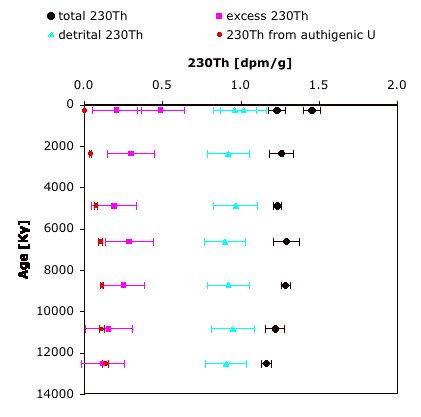
ACS PRF | ACS
All e-Annual Reports

43383-G2
Towards an Improved Paleoflux Proxy for Ocean Margins
230Thorium in marine sediments has been used as a "constant flux proxy". As such, it is a very important tool in paleoceanographic studies that aim to reconstruct the flux of material to the seafloor. Such flux reconstructions are crucial for understanding the history of marine productivity and of dust inputs, among others. Total 230Th in sediment consists of 230Th scavenged from seawater, 230Th present as detrital minerals, and, in some cases, 230Th that has been produced by the decay of authigenic U in sediments. As only the scavenged 230Th is useful as a constant flux proxy, it is necessary to correct for contributions from the other sources of 230Th. This can introduce errors and uncertainties where these corrections are large, such as in ocean margin sediments. The goal of this project is to come up with a way of chemically separating the scavenged 230Th from the detrital and "authigenic" 230Th. Our approach was to use a flow through leaching procedure, in contrast to batch methods that have been tried in the past. With a flow-through technique, the possibility of readsorption of leached Th is reduced, since leachate is constantly flowing over the sediment. During the past year the PI and graduate student Jesse Muratli have developed the capability to accurately and precisely measure Th and U isotopes in marine sediments by isotope-dilution, ICP-MS. Work has focused on a set of sediment samples from the Chilean margin. The sediments were recovered during ODP Leg 202, and come from three sites: 1233, 1234, and 1235. We are interested in reconstructing biogenic particle flux at the deeper of these three sites (1233 and 1234) in order to determine whether changes in intermediate water oxygenation were driven primarily by changes in ocean circulation or changes in local productivity. Analysis of these sediments is challenging because 230Th concentrations are low and 232Th concentrations are very high, resulting in significant 'tailing' of 232Th counts into adjacent mass ranges. We have optimized the ICP-MS to deal with these challenges.
Results from Holocene sediments at site 1234 illustrate the need for a procedure to separate scavenged from detrital 230Th. At this site, because particle flux is great (which dilutes 230Th), the water depth is shallow, and lithogenic fluxes are high, over half of the 230Th is of detrital origin (Figure 1). The amount of "excess 230Th", used to determine particle flux, is thus very sensitive to the correction for detrital 230Th. Uncertainty in the detrital correction accounts for 50-75% of the uncertainty in reconstructed particle flux at this site. In this example detrital 230Th (derived from decay of detrital 238U) was estimated from 232Th concentration assuming a U/Th ratio in lithogenic material of 0.7 +/- 0.1. A procedure to experimentally separate scavenged from detrital 230Th will help determine whether or not the detrital U/Th ratio was constant through time, or changed, perhaps in response to changing river drainage patterns. This year we re-designed our flow-through leaching apparatus, because we found the previous design did not work well with all sediment types, and did not allow sufficient contact between sediment and the leaching solution. The new set-up (Figure 2) is very inexpensive, simple, and effective. It does not leak, there are no back-pressure issues, and we have verified that sediment mass is conserved. We have run a handful of leaching experiments with the system. We also ran a handful of experiments using batch leaching. The samples are dried and waiting to be analyzed.
Note that PI Chase took maternity leave in 2007, which necessarily slowed progress on this project. A no-cost extension has been granted to this award.
Figure 1: Concentration of 230Th in Holocene sediments at site 1234 (1015m) on the Chilean margin. This site represents an extreme case of applying the 230Th flux-normalization approach to reconstruct particle flux. Total 230Th concentrations are low, and the contribution of detrital 230Th is high. The excess 230Th is thus small and sensitive to the correction for detrital 230Th. Figure 2: Apparatus for flow-through leaching of marine sediment. A 25mm polystyrene filter holder is placed inverted over a magnetic stirrer. Leaching solution is pumped through using a peristaltic pump at 1-3 mL/min. Sediment remains suspended through constant stirring, and the filter at the top prevents loss of sediment from the system. 
